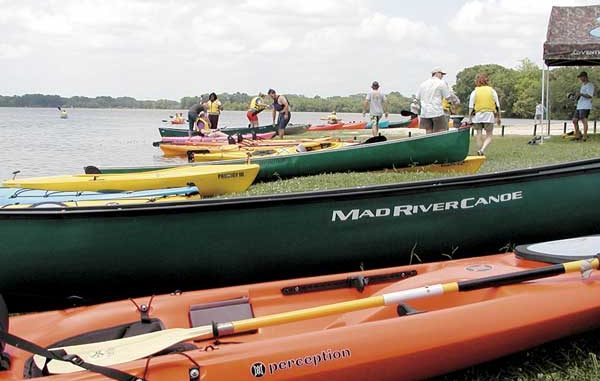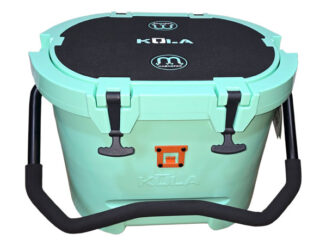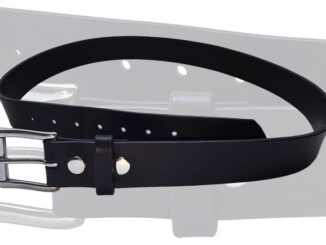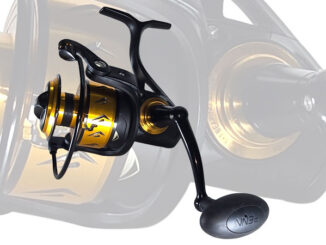
Head out after sunset, and put your skills as a marksman to the test while you fill a cooler with redfish and sheepshead.
An unofficial poll conducted earlier this year on the highly respected website beerdrinkers.com found that puddling is one of the hottest new sports in America, second only to sleep-jogging (like sleep-walking but at a faster pace). What is puddling? Webster defines it as “the sport of fishing from a paddlecraft.” Don’t bother looking it up in a dictionary: This definition comes from my friend Webster Boudreaux.
Boudreaux’s father fished from a pirogue, as did his father. The only things new about puddling are it’s popularity and the types of boats.
In fact, this year marks a special occasion for me. It’s the 20th anniversary of my first fish from a kayak.
Lisa and I were vacationing back then in Captiva, Fla., when we came across two guys at a marina who had rented yaks, putting away their tackle. They talked about how these boats (sit-inside kayaks) enabled them to get deep in the mangroves where the snook lay in ambush.
Next day, bright and early, I rented a yak, and with a commie rod, paddled out to the mangroves. On my third cast, a monster snook swallowed my topwater lure. The ensuing fight created the biggest entanglement of monofilament and mangrove branches in the history of mankind.
In the years after, nearly all my puddling was from a canoe. But the advent — and subsequent improvement — of the sit-on-top (SOT) kayak created a dilemna. As Cormier’s 1st Law of Puddling states, choosing a paddlecraft is an exercise in compromise. Well, I don’t like to exercise, so I didn’t compromise. I added a sit-on-top to my plastic navy.
When it comes to kayaks, I’m still not an expert, but I did sleep at a Holiday Inn Express last night. Hopefully that and many hours on the water are enough to help me answer some of your questions.
Q: SkiDaddy in Mandeville wants to know how to choose the right yak for fishing.
A: Several times each year I attend demos where anyone can test paddle models of kayaks and canoes. I highly recommend attending one of these and test-driving before you buy. If that’s not an option, then do some research on the web. There’s an excellent owner-review database at www.paddling.net.
Also, get familiar with the term “right-sizing.” Every kayak has a capacity-weight rating. You want to look at those models for which your body weight-to-capacity ratio is roughly two-thirds, definitely not more than 75 percent nor less than 50 percent. Too low a ratio, and too much of the hull sits above the waterline, resulting in poor tracking and wind resistance. Too high a ratio, and the yak sits too close to the waterline resulting in a wet ride.
Q. Christina in Bossier City wonders if angler-version yaks are a smart buy.
A: It depends. Until recently, most angler-versions were simply recreational kayaks fitted with a load of accessories and colored dark green — supposedly making them invisible to the fish, but in reality, only to powerboats and jets skis. Not to mention dark colors get hot in the summer sun. Unless you’re using your yak for hunting, bright colors are the way to go.
Most puddlers are DIY folks — they take enjoyment in customizing a boat for their needs. Best example of this is the so-called “milk crate technology” where puddlers take a standard milk crate that fits in the tankwell behind the seat, and rig the crate everyway possible.
In the last few years, manufacturers have responded by creating boats specific for fishing, in standard colors and fitted with only the basics, such as rod holders. The Wilderness Systems Ride, the Perception Search, the Malibu X-Factor, the Ocean Kayak Prowler and the Liquidlogic Manta Ray are a few examples.
Q: Butch in Baton Rouge asks if aluminum canoes are good for fishing.
A: First of all, any paddlecraft is better than no paddlecraft at all. However, aluminum canoes have a nickname in Louisiana: “Cajun Broilers.” Yes, they’re hot in summer, and in winter they’re cold, and all year-round, they’re noisy. Nearly all canoes today are made from polyethylene, royalex or fiberglass. I’d stick to the first two materials.
Both are really quiet. Poly is heaviest, but it’s also very cheap and will take a beating, even from oyster shells in the marsh. Another advantage of a heavy canoe is that it’s usually stable enough to stand up and fish, and like my Old Town Guide, even push pole!
Q: Taylor in Independence seeks suggestions for a book on kayak fishing.
A: Until recently, the few books available weren’t worth your green paper. Then in July, Heliconia Press released “Kayak Fishing: The Ultimate Guide” by Scott Null and Joel McBride. This book is the most comprehensive guide I’ve seen, covering such topics as paddling strokes, safety, fighting and landing fish, rigging and much more. Lots of great photographs as well. Retail price is $20.
I met up with Null back in June at one of Backpacker’s demos in Baton Rouge. Turns out he and fellow Texas kayak fishing guide Dean “Slowride” Thomas were responsible for the cockpit design on the recent revisions of the Wilderness Systems models Tarpon and Ride and the new Perception Search. Null says that with each successive model, smarter improvements were made. He believes the Ride and Search may be the best fishing yaks ever.
Upcoming events
Saturday, Sept. 22 marks the 23rd annual Louisiana National Hunting and Fishing Day, sponsored by the Department of Wildlife and Fisheries, with events held at DWF locations in Baton Rouge, Monroe, Minden and Woodworth. Admission is free, with fun for the family. Among the numerous exhibits are fly fishing and fly tying.
Once again, LDWF is seeking the help of local fly fishing clubs and/or enthusiasts. Please contact Thomas Gresham at (225) 765-2925 for more details.
Saturday, Oct. 13 will be the second-annual Saltwater Fly Fishers Picnic at Woodland Plantation in Myrtle Grove. It’s a chance to meet and learn from some of the biggest names in fly fishing as well as top guides from around the Gulf Coast and beyond. Special guests include Stu Apte, Flip Pallot, Enrico Puglisi and other greats.
Presentations, fly casting, fly tying, exhibits, flats skiffs, kayaks and all-you-can-eat lunch and dinner are included in the $50 registration price.
Last year’s event drew folks from as far as New York and Arizona. Pre-registration is recommended as attendance is limited to 200. To register or get more info, contact Alec Griffin at neworleansflyfishing@gmail.com.


